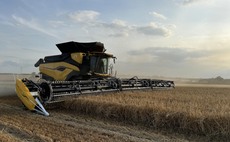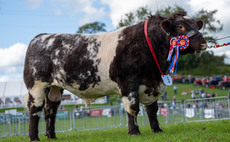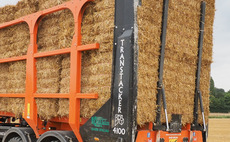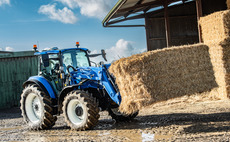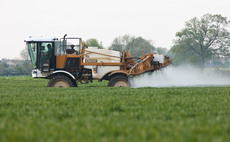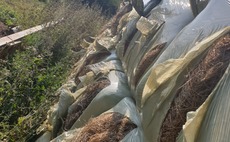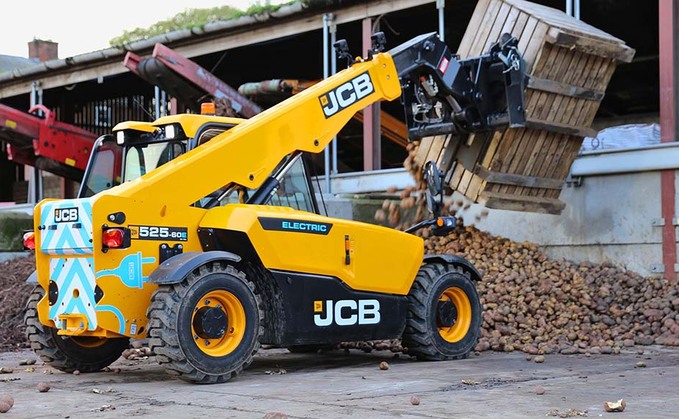
As the buzz around electrification of farm machines marches on, the latest manufacturer to join the fray is JCB with its 525-60E telehandler. To see what the battery powered loader is capable of, Alex Heath put it to work on a range of tasks on a beef unit and a potato grading line.
In recent months, JCB has been at the forefront of rolling out zero-emissions machines, launching a whole portfolio of battery powered options, under the E-Tech branding. Products range from mini-diggers to site dumper trucks to industrial fork lifts and access platforms. And one of the largest and most exciting machines for us is the 525-60E.
Capable of lifting 2,500kg to six meters, from a distance it looks very similar to its diminutive diesel cousin, of the same name, minus the ‘E'. However, while the panel work maybe consistent between the two machines, underneath, they are radically different.
The firm says it has been designed from the ground up as an electric vehicle, and it has not simply had the diesel powerplant replaced with a battery and motor. The chassis is redesigned, as less holes need to be drilled in it to accommodate drive shafts. Likewise, the positioning of components has been rethought, and strategically placed from better weight distribution, as cables and hoses provide more flexible routing.
Armed with an array of tools, we got stuck into a deep litter cattle court, really testing the little loader's ability to tear out heavy muck, as well as using it around a potato grading line, a major market that the machine is being targeted at.
Drivetrain
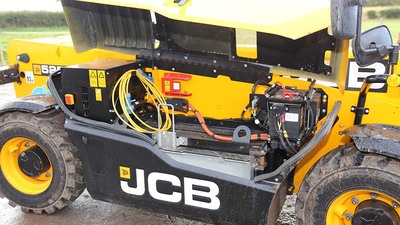
JCB has retained the side mounted ‘engine bay', where the purr of a diesel engine is replaced by the hum of batteries, inverters and other electrical gadgetry.
One battery capacity is offered, a 24kWh lithium ion store, running at 96-volts. Placed low down, this provides the ballast lost with the removal of the ICE.
An array of cables emerge from this substantial lump and transport current to a pair of motors. The first is at the rear of the boom and used for all hydraulic functions. This motor produces 22kW (29.5hp) and is coupled directly to a gear pump putting out 65 litres/minute. Also at the rear is a 44-litre reservoir. The reason for its position is simple: it adds more rear end ballast.
The second motor is a 17kW (22.7hp) unit, coupled to a transfer box that splits power between both axles. A short shaft sends power to the front and a longer one to the rear. A drum brake on the transfer box is used for braking, but in reality, this is used very little. Under braking, the battery recoups some of the energy.
For ancillaries around the loader; lights, wiper, heated window, heater/blower etc, a 12V system is used, which is charged off the main battery using a DC to DC charging system.
drivetrain 2
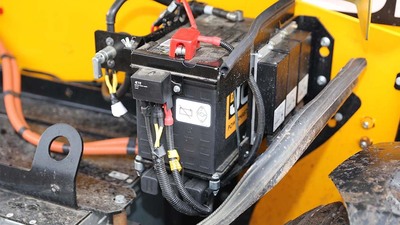
From its telematics data of existing diesel machines in this class, the manufacturer says the amount of storage on board would see 90 per cent of its customers covered for a ‘normal working day'. This has to be rationalised by the fact when an engine is on idle, it is still burning fuel. When the e-loader stops, energy use is all but non-existent, depending on how many ancillaries are running.
The manufacturer does not quote a length of time the machine will run for and it is entirely dependent on the type of work you are doing. Tootling round a yard, moving a stacking boxes, or pushing up feed and scraping out, we could envisage maybe 6 hours of meaningful work, before bailing out to recharge. What we did find however, mucking out with the grab soon drained the battery. We started off in the mid-morning with 75 per cent charge and an hour and a half later the figure stood at 14 per cent. In reality, lifting heavy material and running an attachment on the third service will see about two hours of work completed, before needed a top up.
Driving the machine is a simple affair, very much point and shoot. It behaves very much like its diesel stable mate, but vibrations and engine noise are obviously non-existent.
Pushing into a muck pile sees the wheels slip fairly shortly after engaging with it, but using the hydraulics to make a decent load is easy enough. Top speed is a sedate 15kph, but it is unlikely this machine will ever do much roading, or field work for that matter.
Hydraulics

The rear mounted gear pump and electric motor provides plenty of poke for hydraulic functions allowing for multiple operations to be carried out at once. Booming up and out while tipping is a doddle.
Because it is run from an electric motor with 100 per cent torque from start up, operations are swift. They are also independent of the throttle, which is used exclusively for travel speed.
Using the same boom as its diesel counterpart, regenerative hydraulics feature, allowing for rapid retraction and lowering of the boom. However, finesse is not one of the loaders strong points and a lot of care has to be take when lowering the boom, especially with a grab on. Likewise, the feel back from the joystick makes it difficult to realise where the tips of the tines or the heel plate on the grab is, not ideal when clearing sheds at a helter-skelter rate as is often the case.
For pallet and box work however, where more care is naturally taken, it is easy enough to ensure the correct pallet tine placement, and inching into said items is also a breeze, with the on/off driving style an electric loader affords you.
We would like to see some handling modes added that perhaps slowed hydraulic performance at times and allowed for the setting of carriage postion, just to make jobs like mucking out that bit easier.
Lift capacity is a breath of fresh air, and in the time we had the loader, not once did the EN15000 load limiter lock out the hydraulic functions. Even with the 1.7cu.m grab full of wet, heavy muck full use of the hydraulics was possible, allowing you to make the most of its 2.5t load rating.
pic

Charging and run time
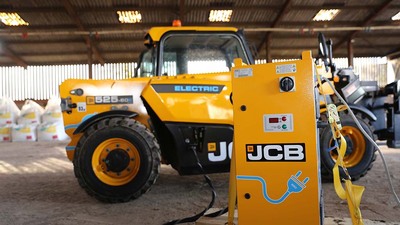
The thing you quickly realise with all electric vehicles and this is not just an isolated case with JCB, is the need for proper planning. On farms where a set routine is implemented every day, such as scraping and pushing up feed on a dairy unit, the logistics of run time and charging intervals can be much better defined.
However, on a mixed farm where there are quiet periods, busy ones and spur of the moment frenzied activity, the level of the battery can catch you out and curtail activities for a period of time.
We are sure that after a period of time with the loader, you would soon realise how long certain jobs take and make strategic breaks throughout the day to enable a grab of charge.
With this in mind, the manufacturer has a clutch of charging options. Up first and always handy to have is the onboard 3kW unit, that plugs into an industrial-three pin 240V/16A supply. This stays with the machine permanently and would be ideal for overnight charging on a remote site that does not have three phase supply. It will charge from zero to 100 per cent in about eight hours.
charging 2
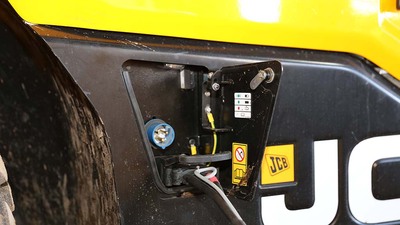
There is then a three phase charging option off board. The 415V/32A Rapid Charger will replenish the battery from empty to full in just under two hours. We think the rapid charger, priced at £6,514.75 is a must have.
All charging methods use a little hatch under the bonnet, and there is a sensor that ensures the machine cannot be driven away while the hatch is open.
The manufacturer says the battery is good for 5,000 charging cycles, before the battery capacity dips below 80 per cent. in reality, it reckons this will take about 10 years on most farms.
Cab
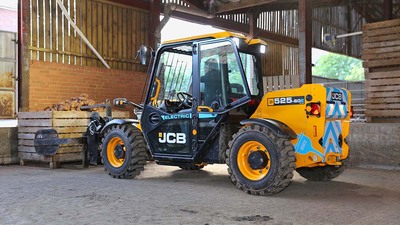
The cab frame is the same as that used on the diesel variant, and a relatively sparse affair, with few luxuries. There is a 2kW heater/blower that does an alright job of clearing steamy windows, however, the front and right windows have heating elements embedded in the glass which are handy for clearing moisture and frost in the winter months.
Controls are logical. There is enough adjustment of the steering column and seat to get comfy, while most controls are on a blister pack beneath the joystick armrest.
LED lights feature throughout. Using little energy, the light output is impressive and makes working in dingy spots easy enough. We found that using the lights when entering and exiting the grading shed also made for a safer working environment and another warning for pedestrians the whisper quiet machine is about.
A small screen is nestled into the plastic cowling in the front right corner of the cab and shows all the necessary operating data, including speed, travel direction, wheel alignment and charge level.
cab 2
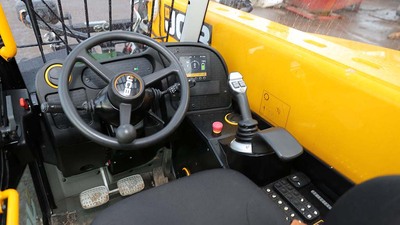
Visibility through out the machine is exceptional, with a low boom pivot point, nearly all four corners of the machine can be seen from the heated and suspended seat. The only exception being the forward view. Fitted with the manufacturer's Q-fit headstock in our opinion, it is just too large for this size of machine. However, upward views when tipping into a trailer or stacking boxes are ideal.
It is not a big machine either, fitting in the same profile as its fossil fuel cousin, and measuring less than two metres in height or width, lending itself to a variety of applications, from chicken sheds to cow cubicle to poly tunnels and more.







